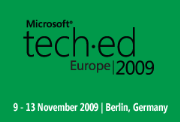As I’ve done the past two years, here’s a list of all the places I’m going in the next fiscal year. Traditionally, I’ve done this post by calendar year, but all MSFT planning is done by FY and so invariably I miss events early in the calendar year but late in the fiscal (like PyCon last year). I’ll be updating this post periodically as I get tapped for more presentations. There are several other conferences I’m considering, submitting sessions for, in discussions with, but these are the ones that are confirmed.
Danish University Tour, Sept 7-11
My FY10 travels first take me to Copenhagen, where I was invited by the
local subsidiary to present at four different universities in a single
week. Don’t know how much sightseeing I’ll get done, but I’ll sure be
talking a lot. My host Martin Esmann
writes Stud.blog for Danish
ComputerWorld and has a
post (in Danish) about
my visit. Personally, I am just excited about being featured in
something called “Stud.blog”!
😄
Actually, Stud here means “Student” not “slender, upright members of
wood” or any other
definition of the term “stud”.
I’ll be visiting Aalborg University, Aarhus University, University of Southern Denmark and University of Copehhagen as well as delivering a TechTalk at the Microsoft Development Center Copenhagen, which is Microsoft’s biggest development center in Europe. I’ll primarily be delivering my Iron Languages introductory talk “Pumping Iron”, but there’s also some interest in language development on the DLR so I’ll be talking on that topic as well.

patterns & practices Summit Redmond 2009, Oct 12-16
This will be my third p&p Summit in a row and fourth in five years. This
year, I’m doing a talk called “Not Everything is a new Nail() : How
Languages Influence Design”. I was supposed to deliver this talk last
year, but got side track with my day job and ended up talking about
IronPython instead. Keith has made it
VERY clear he doesn’t want another last minute substitution again this
year.
Turing award winner Alan Perlis is credited with saying ‘A language that doesn’t affect the way you think about programming is not worth knowing.’ Yet, most programmers rarely venture outside of the comfort zone of statically-typed object-oriented languages. Our heavy use of object-oriented languages influences our thinking to the point that we can?t see alternative approaches at all. This isn?t to say the object-oriented languages are bad, but as is typical in most things, there is no one ‘best’ way for all situations. In this talk, VS Languages PM Harry Pierson will look at a given software development scenario from both the object-oriented and functional perspectives, in order to see how much on an influence language really has on our engineering efforts.

Tech·Ed Europe 2009, Nov 9-13
I knew I was going to be updating this post over time, but I didn’t
expect to have to update it so soon! Literally the day after I posted
this, I got the speaker invite for Tech·Ed Europe 2009. My session
hasn’t been posted yet, but this is the abstract we submitted:
Dynamic Languages on the Microsoft .NET Framework
The Dynamic Language Runtime (DLR) adds a shared dynamic type system, a standard hosting model, and support for generating fast dynamic code to the CLR. IronPython and IronRuby are Microsoft’s dynamic language implementations on .NET. In this talk, we’ll show you how to interactively create great .NET applications using dynamic languages. You’ll walk away knowing why dynamic languages deserve a spot in your toolbox!
It’s kind of generic, but given that most of the audience probably hasn’t seen IronPython or IronRuby, having broad latitude in my presentation topic is a good thing. I’ll probably deliver a variant of my standard “Pumping Iron” talk like I’m doing in Denmark. I delivered it recently at an internal event with Jimmy, so there’s lots more IronRuby content than there used to be.
The only bummer about doing Tech·Ed Europe is that I’m only doing one measly talk. I’m asking around – I’d love to do a .NET user group or university talk while I’m in town. Any takers?

Microsoft Professional Developers Conference 2009, Nov 17-19
Update:
Tech·Ed Europe and PDC are on back-to-back weeks this year so we’ll be
sending a teammate-to-be-determined to PDC in my stead. My family is
very pleased I won’t be gone for two weeks straight.
Last year, I was on the content team for PDC. This year, that PITA
responsibility belongs to someone else so I might actually get real work
done in the four weeks leading up to PDC. My team will tell you, last
year PDC sucked up 100% of my time for a month as we were driving
towards our 2.0 release.
Technically, I haven’t had a talk for PDC accepted yet. But I
submitted three and two are looking good (though I assume only one will
make it to the actual show) so I thought I’d just go ahead and include
it on this post. If/when my talks get accepted, I’ll post links and
abstracts. Also, if one of my PDC talks is accepted, I’ll probably
submit a talk for SoCal Code Camp
as well.

PyCon 2010, Feb 19-21
This will also be my third PyCon in a row, though PyCon last year was a
bit of a whirlwind since I had literally just joined the IronPython
team. I finally feel like I might have something interesting to present
at PyCon this year. Last year
Dino and
Jim handled
the presentation duties from our team (with Michael Foord and Jonathan
Hartley delivering a
tutorial and Sarah
Sutkiewicz speaking on
FePy). We
already have one announcement that I think is pretty significant lined
up and might have a second depending on how hard I can push LCA and
management between now and then. Talk proposals are due October 1st, so
any suggestions would be appreciated!


